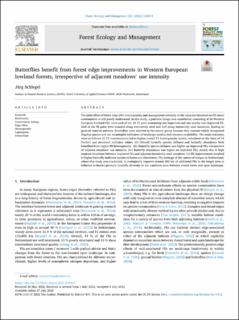Please use this identifier to cite or link to this item:
https://doi.org/10.21256/zhaw-25380Full metadata record
| DC Field | Value | Language |
|---|---|---|
| dc.contributor.author | Schlegel, Jürg | - |
| dc.date.accessioned | 2022-08-05T09:30:31Z | - |
| dc.date.available | 2022-08-05T09:30:31Z | - |
| dc.date.issued | 2022 | - |
| dc.identifier.issn | 0378-1127 | de_CH |
| dc.identifier.issn | 1872-7042 | de_CH |
| dc.identifier.uri | https://digitalcollection.zhaw.ch/handle/11475/25380 | - |
| dc.description.abstract | The joint effect of forest edge (FE) heterogeneity and management intensity of the adjacent farmland on FE insect communities is still poorly understood. In this study, a pairwise design was established, consisting of 36 Western European lowland FEs, with each of the 18 FE pairs containing one improved and one nearby non-improved FE. Half of the FE pairs were situated along extensively used and half along intensively used meadows, leading to gradual contrast patterns. Butterflies were selected as the survey group because they contain widely recognized flagship species and are meaningful indicators of landscape quality and resource availability. The main outcomes were as follows: (i) FE improvements led to higher overall FE heterogeneity scores, calculated on the basis of 16 floristic and structural indicator values. (ii) Overall butterfly species richness and butterfly abundance both benefited from higher FE heterogeneity. (iii) Butterfly species richness was higher on improved FEs, irrespective of adjacent meadows’ use intensity. (iv) Butterfly abundance was higher on improved FEs, mainly due to high contrast situations between improved FEs and adjacent intensively used meadows. (v) FE improvements resulted in higher butterfly indicator species richness and abundance. The strategy of the canton of Aargau in Switzerland, where this study was conducted, to ecologically improve around 200 km of additional FEs in the longer term is believed to further promote butterfly diversity in the transition zone between closed forest and open landscape. | de_CH |
| dc.language.iso | en | de_CH |
| dc.publisher | Elsevier | de_CH |
| dc.relation.ispartof | Forest Ecology and Management | de_CH |
| dc.rights | http://creativecommons.org/licenses/by/4.0/ | de_CH |
| dc.subject | Biodiversity | de_CH |
| dc.subject | Conservation biology | de_CH |
| dc.subject | Edge effect | de_CH |
| dc.subject | Heterogeneity | de_CH |
| dc.subject | Lepidoptera | de_CH |
| dc.subject | Switzerland | de_CH |
| dc.subject.ddc | 333.7: Landflächen, Naturerholungsgebiete | de_CH |
| dc.title | Butterflies benefit from forest edge improvements in Western European lowland forests, irrespective of adjacent meadows’ use intensity | de_CH |
| dc.type | Beitrag in wissenschaftlicher Zeitschrift | de_CH |
| dcterms.type | Text | de_CH |
| zhaw.departement | Life Sciences und Facility Management | de_CH |
| zhaw.organisationalunit | Institut für Umwelt und Natürliche Ressourcen (IUNR) | de_CH |
| dc.identifier.doi | 10.1016/j.foreco.2022.120413 | de_CH |
| dc.identifier.doi | 10.21256/zhaw-25380 | - |
| zhaw.funding.eu | No | de_CH |
| zhaw.issue | 521 | de_CH |
| zhaw.originated.zhaw | Yes | de_CH |
| zhaw.pages.start | 120413 | de_CH |
| zhaw.publication.status | publishedVersion | de_CH |
| zhaw.volume | 2022 | de_CH |
| zhaw.publication.review | Peer review (Publikation) | de_CH |
| zhaw.webfeed | Umweltplanung | de_CH |
| zhaw.funding.zhaw | Entomologische Bewertung von Waldrändern | de_CH |
| zhaw.author.additional | No | de_CH |
| zhaw.display.portrait | Yes | de_CH |
| Appears in collections: | Publikationen Life Sciences und Facility Management | |
Files in This Item:
| File | Description | Size | Format | |
|---|---|---|---|---|
| 2022_Schlegel_Butterflies-benefit-forest-edges_Forest-Ecology-Management.pdf | 1.35 MB | Adobe PDF |  View/Open |
Show simple item record
Schlegel, J. (2022). Butterflies benefit from forest edge improvements in Western European lowland forests, irrespective of adjacent meadows’ use intensity. Forest Ecology and Management, 2022(521), 120413. https://doi.org/10.1016/j.foreco.2022.120413
Schlegel, J. (2022) ‘Butterflies benefit from forest edge improvements in Western European lowland forests, irrespective of adjacent meadows’ use intensity’, Forest Ecology and Management, 2022(521), p. 120413. Available at: https://doi.org/10.1016/j.foreco.2022.120413.
J. Schlegel, “Butterflies benefit from forest edge improvements in Western European lowland forests, irrespective of adjacent meadows’ use intensity,” Forest Ecology and Management, vol. 2022, no. 521, p. 120413, 2022, doi: 10.1016/j.foreco.2022.120413.
SCHLEGEL, Jürg, 2022. Butterflies benefit from forest edge improvements in Western European lowland forests, irrespective of adjacent meadows’ use intensity. Forest Ecology and Management. 2022. Bd. 2022, Nr. 521, S. 120413. DOI 10.1016/j.foreco.2022.120413
Schlegel, Jürg. 2022. “Butterflies Benefit from Forest Edge Improvements in Western European Lowland Forests, Irrespective of Adjacent Meadows’ Use Intensity.” Forest Ecology and Management 2022 (521): 120413. https://doi.org/10.1016/j.foreco.2022.120413.
Schlegel, Jürg. “Butterflies Benefit from Forest Edge Improvements in Western European Lowland Forests, Irrespective of Adjacent Meadows’ Use Intensity.” Forest Ecology and Management, vol. 2022, no. 521, 2022, p. 120413, https://doi.org/10.1016/j.foreco.2022.120413.
Items in DSpace are protected by copyright, with all rights reserved, unless otherwise indicated.